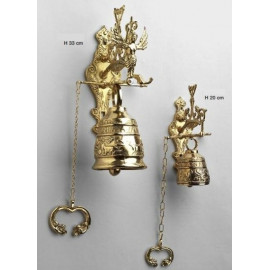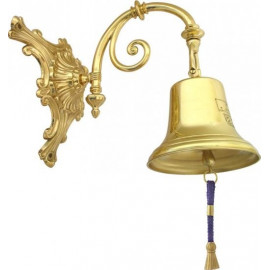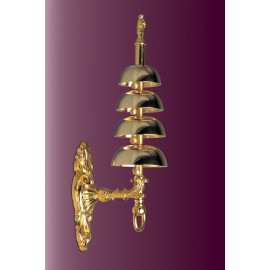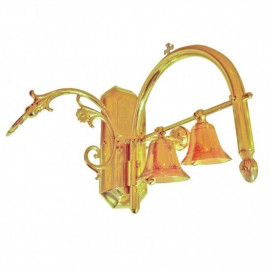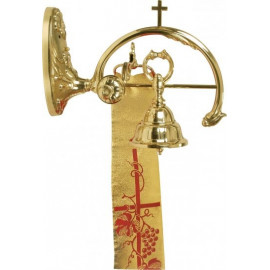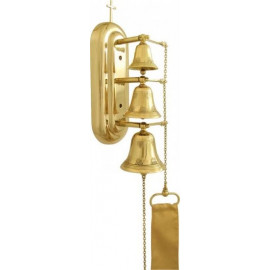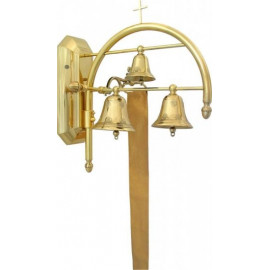No products
Product successfully added to your shopping cart
There are 0 items in your cart. There is 1 item in your cart.
Sanctuary Bells
- Altar Bell and Gong
- Candle Snuffer
- Candlestick
- Catholic Pyx
- Chalices
- Church wall lamps
- Ciborium
- Crosses and Crucifix
- Cruets & Trays
- Holy Water Font
- Holy Water Pot
- Missal Stand
- Monstrance Tabor
- Monstrances
- Offering Baskets
- Oil Stock
- Patens
- Reliquaries
- Sanctuary Bells
- Sanctuary Lamp
- Sprinkler
- Thurible, Boat, & Spoon
- Travel Liturgy & Mass Kit
Sanctuary bells, also known as altar bells or sacring bells, are small bells that are traditionally used in Christian liturgical worship. They are typically found in churches and are used during specific parts of the Mass or other liturgical services.
The primary purpose of sanctuary bells is to draw attention and signify essential moments during the Eucharistic celebration. They are rung at specific points in the Mass to alert the congregation to moments of significance and to create a respectful atmosphere.
Sanctuary bells, also known as altar bells or sacring bells, are small bells that are traditionally used in Christian liturgical worship. They are typically found in churches and are used during specific parts of the Mass or other liturgical services.
The primary purpose of sanctuary bells is to draw attention and signify essential moments during the Eucharistic celebration. They are rung at specific points in the Mass to alert the congregation to moments of significance and to create a respectful atmosphere.
Sanctuary Bells There are 7 products.
The Enchanting World of Church Sanctuary Bells
Church sanctuary bells have been a cornerstone of Christian worship for centuries, weaving a tapestry of sound that calls the faithful to prayer and marks the sacred moments of the liturgy. These bells are not just instruments; they are the voice of the church, speaking across cities and countryside, inviting all to pause and reflect on the divine.
The Historical Significance of Sanctuary Bells
The tradition of using sanctuary bells in Christian worship can be traced back to the early medieval period. Initially introduced by Saint Paulinus of Nola in the 5th century, these bells served as a call to worship, summoning monks and the faithful to prayer. By the 7th century, Pope Sabinianus had officially sanctioned their use, marking the beginning of a long history of bells in the church.
A Symphony of Faith
Imagine walking through a medieval town; the sound of the sanctuary bells cuts through the air, a clear, resonant call to worship. These bells were not just functional; they were a symbol of the community's spiritual life, a reminder of the presence of God in the midst of daily toil.
The Role of Sanctuary Bells in Modern Worship
Today, church sanctuary bells continue to play a vital role in the liturgy. They signal the start of the Mass, the consecration of the Eucharist, and other significant moments, creating an auditory landscape that enhances the worship experience.
A Call to Prayer and Reflection
In the hustle and bustle of modern life, the sound of sanctuary bells is a powerful call to pause and reflect. Whether tolling solemnly for a funeral or pealing joyfully for a wedding, these bells remind us of the sacredness of life's key moments.
The Art and Craft of Sanctuary Bells
Crafting sanctuary bells is an art form that has been refined over centuries. Made from bronze or brass, each bell is carefully tuned to produce a sound that is both clear and resonant. The size and shape of the bell, along with the skill of the bell-ringer, all contribute to the unique voice of each church's bells.
The Bells of St. Patrick's Cathedral
Take, for example, the 19 bells of St. Patrick's Cathedral in New York City. Cast by the G. & F. Paccard Company in France, these bells range in weight from 137 lbs to over 6,600 lbs, creating a rich tapestry of sound that has become an integral part of the cathedral's identity.
FAQs About Sanctuary Bells
Q: Why do churches have sanctuary bells?
A: Churches use sanctuary bells to mark significant moments in the liturgy, call the faithful to worship, and create an atmosphere of reverence and solemnity.
Q: Can anyone ring the sanctuary bells?
A: Typically, the ringing of sanctuary bells is reserved for ordained clergy or trained bell-ringers. However, some churches may allow laypersons to participate in bell-ringing for special occasions.
Q: Are sanctuary bells different from other church bells?
A: Yes, sanctuary bells are specifically used within the liturgy to mark key moments of the Mass. Other church bells may be used to signal the time of day or call the community to prayer.
Q: How are sanctuary bells made?
A: Sanctuary bells are typically cast from bronze or brass and then tuned to produce a specific pitch. The crafting of these bells is a skilled trade that combines artistry with precision engineering.
The Timeless Appeal of Sanctuary Bells
Church sanctuary bells are more than just historical artifacts; they are a living tradition that continues to enrich the worship experience for Christians around the world. Whether calling the faithful to prayer or marking the sacred moments of the Mass, these bells are a testament to the enduring power of sound to evoke the divine.

